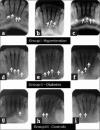Evaluation of mandibular anterior nutrient canals in hypertensive and diabetes mellitus patients: A comparative radiographic study
- PMID: 31007493
- PMCID: PMC6450156
- DOI: 10.4103/tcmj.tcmj_43_18
Evaluation of mandibular anterior nutrient canals in hypertensive and diabetes mellitus patients: A comparative radiographic study
Abstract
Objective: Radiographic evaluation of nutrient canals (NCs) in the mandibular anterior region using intraoral periapical radiographs (IOPARs) and to determine whether they can be used as a potential marker for hypertension (HT) and diabetes mellitus (DM).
Materials and methods: Randomly selected 600 patients of 21-60 years age group (Group I: 200 HT; Group II: 200 DM; Group III: Healthy subjects) were considered. The case history was recorded including details for DM and HT (duration, type, and medication). Blood pressure was measured, followed by blood examination for blood sugar levels. Selected patients were subjected to IOPARs using CS-2100C machine by the paralleling technique. Selected radiographs were evaluated by two observers independently for the presence/absence, number, and location of NCs between #33 and #43. Data obtained were tabulated and subjected to statistical analysis using SPSS 20.0 statistical software and intergroup reliability was checked using Cohen's kappa test.
Results: Evaluation of various parameters of NCs showed an insignificant interobserver bias. The incidence of NCs presence was noted maximum in Group II (93.5%), followed by Group I (88.5%) and III (44.5%). Of total 888 NCs found, maximum were found in Group I, followed by II and III. On comparing the incidence of NCs present among both genders and location in study groups, no statistical correlation was found.
Conclusion: Statistically significant increase in the incidence and number of NCs in Group I and II compared to controls can act as an adjunct diagnostic marker for the detection of DM and HT; although, no significant correlation was obtained between gender and location of NCs in different study groups. Furthermore, there was no significant correlation was found between the severity of disease and incidence of the presence of NCs.
Keywords: Diagnostic marker; Intraoral; Mandibular anterior region; Vascular channels.
Conflict of interest statement
There are no conflicts of interest.
Figures
Similar articles
-
Prevalence of nutrient canals in mandibular anterior intra-oral periapical radiographs (IOPARS) in patients with chronic systemic diseases - a cross-sectional study.J Med Life. 2022 May;15(5):661-668. doi: 10.25122/jml-2022-0009. J Med Life. 2022. PMID: 35815094 Free PMC article.
-
Incidence of nutrient canals in hypertensive patients: A radiographic study.J Nat Sci Biol Med. 2014 Jan;5(1):164-9. doi: 10.4103/0976-9668.127318. J Nat Sci Biol Med. 2014. PMID: 24678218 Free PMC article.
-
Prevalence of nutrient canals in diabetes mellitus and hypertension: A radiographic study.J Pharm Bioallied Sci. 2013 Jun;5(Suppl 1):S21-4. doi: 10.4103/0975-7406.113286. J Pharm Bioallied Sci. 2013. PMID: 23946569 Free PMC article.
-
Radiographic study of mandibular nutrient canals.Ann Dent. 1992 Winter;51(2):17-21. Ann Dent. 1992. PMID: 1463311 Review.
-
Panoramic radiography in dental diagnostics.Swed Dent J Suppl. 1996;119:1-26. Swed Dent J Suppl. 1996. PMID: 8971997 Review.
Cited by
-
Prevalence of nutrient canals in mandibular anterior intra-oral periapical radiographs (IOPARS) in patients with chronic systemic diseases - a cross-sectional study.J Med Life. 2022 May;15(5):661-668. doi: 10.25122/jml-2022-0009. J Med Life. 2022. PMID: 35815094 Free PMC article.
References
-
- Hirshfeld I. A study of skulls in the American Museum of natural history in relation to periodontal disease. J Dent Res. 1923;5:241–65.
-
- Stafine EC, editor. Oral roentgenographic diagnosis. 3rd ed. Philadelphia: WB Saunders Company; 1969. Anatomic landmarks; pp. l–15.
-
- Goaz PW, White SC, editors. Oral radiology. 2nd ed. St. Louis: CV Mosby Company; 1987. Normal radiographic anatomy; pp. 174–99.
-
- Carroll MJ, Hirschmann PN. The involvement of nutrient canals in periapical pathology. Dentomaxillofac Radiol. 1980;9:18–20. - PubMed
-
- Grondahl K, Ekestubbe A, Grondahl HG. Goteburg: Nobel Biocare; 1996. Radiography in oral enddosseous prosthetics.



